Marienfelder Altar
The Marienfelder Altar is an altar from the former Marienfeld monastery of the Cistercians in the town of Harsewinkel in the Münsterland.
It consists of a total of 16 panels, each measuring 93 × 65 cm, eight scenes from the Passion of Christ and eight from the life of Mary and Christ. The altar stood in the high choir of the monastery from 1457 to 1681 . These panels were painted by the Westphalian painter Johann Koerbecke . 15 panels have been preserved. Similar to the Liesborn Altar , they are scattered in museums from Chicago to Moscow .
Origin and dispersion
At the time of Abbot Hermannus von Warendorf (1410–1443), the Marienfeld monastery was given 43 Rhenish guilders to restore the west window of the church, which, however, left the money untouched. His successor Arnoldus von Bevern (1443–1478) instructed the then treasurer Johannes Alen to pay out the money to the painter Johann Koerbecke as a fee for the altarpieces. The time of origin of the Marienfeld Retable can therefore be set between 1443 and 1457.
The altar was erected in praise of the Trinity , the Body of Christ , the Virgin Mary and all saints on February 6, 1457. Johannes Wennecker , Auxiliary Bishop of Münster, consecrated the altar on June 25, 1458.
From contemporary calculations we know that restorations were carried out on the high altar in 1516/17 and 1533/34. Abbot Hermannus Koelte (1603–1610) had another pair of wings attached. Under Abbot Johannes Stades (1661–1681) the altar structure was replaced by a more contemporary baroque altar that has been preserved to this day. What happened to the pictures of the old altar up to the dissolution of the monastery in 1803 is not known.
In 1804, the Harsewinkler painter Johann Christoph Rincklake was commissioned to draw up an appraisal of the inventory of paintings in the monastery, including the panels on the Marienfeld Altarpiece. It speaks of a tablet that has broken in the middle. To this day nothing is known about the whereabouts of this tablet. Originally, the remaining 15 panels should be sent to the Academy of Fine Arts in Berlin. Instead, they were sold individually and are now among the most widely dispersed works of German medieval art.
description
A pictorial representation of the altar, which was supplemented by another pair of wings in the 17th century, has not survived, but a report by Father Hermann Hartmann from 1715 from the monastery chronicle:
“As usual, the altar panel was set up on the high altar cafeteria, protruding 1.5 or 2 feet wide on each side. In height it did not yet reach the lowest part of that large east window, so it was almost square in height and width. This middle part of the altar was artfully worked in openwork and semi-detached work with various figures so that the 24 sacred skulls of the Ursula Society housed inside the panel and other bones were visible from the outside through small windows. In the middle of this inner panel stood the beautiful statue of the Virgin Mary in a niche, sitting on a throne and carrying the baby Jesus on her lap. Right next to this statue were two wonderful skulls on each side, which were reported above. The others followed in the same order on each side of six, and the remaining holy relics were arranged below. This inner panel was completely gilded and after two centuries it was intact and unchanged, so that nothing of the gilding had disappeared or fell off. Until its last days it appeared so magnificent to visitors that it aroused admiration and devotion. When the sun was shining, you were almost blinded by the bright shine. In its time, two wing panels were attached to the gilded central panel, terminating with it at the lower edge, which were painted inside and outside with magnificent images of the mysteries of the life of Christ. Particularly in these pictures was the design of the robes and faces of Christ, the Virgin Mary, the apostles (among whom the face of James coincided with that of Christ, according to the Gospel, where he is called the brother of the Lord), Pilate, Anna, of the Caiphas, even the Jews and soldiers who could be seen in one picture and shown in the same way on the other ... On weekdays all wings were simply closed, on Sundays and duplex festivals or, as we say, on days with two masses only the first wings open. Then the whole Passion, painted on both sides, could be seen. Finally, on holidays, the second wings were opened (through which the first-mentioned were then covered), which represented the glorious mysteries of Christ. Then the magnificent, gilded and wonderfully devotional interior panel could be seen. "
The following illustration shows the wings created by Johann Koerbecke. When closed, the Passion of Christ could be seen, the open side showed scenes from the life of Jesus and Mary and in between a reliquary with the figure of Mary as the center.
| Left wing outside | Left wing inside | Right wing inside | Right wing outside | ||||
|---|---|---|---|---|---|---|---|
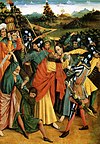
|

|

|

|
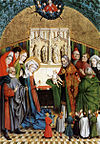
|
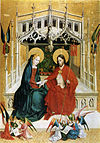
|

|
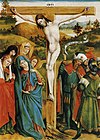
|

|

|

|
probably lost : Adoration of the Magi |

|
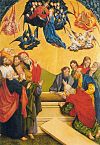
|

|

|
The boards and their locations
In the LWL State Museum for Art and Cultural History in Münster
- Capture of Christ
In the center of the foreground the scene of the Judas kiss . Bottom left suggests Peter the Malchus from the ear. Armored soldiers and some priests on either side. In the background a varied landscape.
- The picture was previously exhibited in the Hinrichsen und Lindpaitner gallery in Berlin.
- Christ before Pilate
The scene takes place in the open market, which is paved with pebbles. Pontius Pilate , who washes his hands, is seated on a Gothic judgment seat . In the foreground, Christ with his hands joined, being tugged and mocked by two executioners. Behind it the people crowded. Various gabled houses in the background.
- Acquired from the Dollfuss collection.
- Mocking Christ
Christ is seated on a raised bench in a hall covered with patterned floor tiles. Minions abuse and mock him. In the open door on the left, the high priest and his companions watch the process.
- Westfälischer Kunstverein, acquired from the Bartels collection.
- Presentation in the temple
The scene takes place in front of a Gothic altar adorned with sculptures, on the sides of which are cloth hangings. In the foreground clerics and junkers with candles in small form. In the golden semicircle of the background God the Father with numerous angels on the clouds.
- Originally in New York, Kleineberger Galerie. 1906 at the exhibition of old German art of the Burlington Club in London under No. 10 of the collection of Henry Wagner.
- Appearance of the risen Christ to Mary
The two figures sit side by side on a throne decorated with a rich Gothic canopy. Mary touches the right hand wound of the Savior. Below on the floor a group of singing angels.
- Originally in Cologne, Wolf Collection
- Entombment of Christ
The body of Jesus is placed in the sarcophagus, which is placed at an angle to the edge of the picture , by Joseph of Arimathea , Nicodemus and a third man. Mary behind the coffin kisses the cheeks, Mary Magdalene in the foreground the hand of the Lord. Johannes and three women stand back complaining. A rich landscape forms the background.
- Westfälischer Kunstverein: Acquired from the Bertels collection with the Mocking of Christ in 1869.
In the Pushkin Museum in Moscow
- Flagellation of Christ
The scene takes place in a hall covered with patterned tiles. Christ is tied to a column in the middle. Through the high windows of the hall you can see a street with high gabled houses.
- Previously with Alexander Brocard in Moscow.
In the National Museum in Krakow
- Temple walk of Mary
Like the Annunciation and the Birth, this picture also has punched edges to close the picture. Little space is left for the gold ground because of the Gothic temple structure. Maria climbs up to the altar on an angled flight of steps. A priest in episcopal vestments awaits them there. A bevy of girls are busy inside the temple. They are visible through Gothic windows. Joachim and Anna kneel at the bottom of the stairs.
At the Art Institute of Chicago
- Annunciation
Maria and the angel under a canopy-like case in front of a curtain held by angels. Above God the Father, from whom the Savior, in child form, descends to Mary. Golden background and patterned slab floor in perspective drawing. On a bench behind Mary and the angel lie three pillows, each with a coat of arms. The middle one is the usual Cistercian coat of arms. The coat of arms on the left shows a blue crossbar on silver, the right a wavy band on silver.
- Reverfon collection guide
In the Germanic National Museum in Nuremberg
- Birth of Christ
Under an open case, Mary kneels in front of the naked boy Jesus lying on the floor, surrounded by a halo, in the company of adoring angels. The sleeping Joseph crouches behind Maria. In the background the Annunciation of the Shepherds. Gold background, soil with flowers on the ground in front left.
- Auctioned at a campaign by the Henry Doetsch Collection in London in 1895, it was long considered lost.
In the National Gallery of Art in Washington, DC
- Ascension of Christ
The Savior disappears against a golden background, surrounded by Pariah and prophets. Angels on clouds at the top left edge. Below on a round hill Mary in the foreground and the apostles.
- Auctioned at the “Exposition de la miniature” in 1912, then privately owned in Basel.
In the Museo Thyssen-Bornemisza in Madrid
- Assumption of Mary
Similar to the Ascension of Christ, the picture has two halves. In front of the gold background above, Mary is received by Christ amid his host of angels. On either side there are two lovely groups of three angels making music. Below are the apostles in two groups on either side of the empty sarcophagus.
- Heinrich Thyssen-Bornemisza Collection at Rohozcz Castle in Hungary. Went there from Westphalian property.
In the State Museums in Berlin
- Christ carrying the cross
In the middle Christ, dragging a mighty cross, soldiers and people around, John and the pious women follow him. A richly turbulent landscape forms the background.
- Crucifixion of Christ
The crucifix stands in front of a mountainous landscape. Left Johannes and the four Marys, right the captain.
- previously in order
In the Musée Calvet in Avignon
- Resurrection of Christ
The Savior emerges from the sarcophagus, which is placed at an angle to the picture edge. In the foreground three frightened guards rebounding, a sleeping guard behind the coffin. A landscape as a background.
literature
- Reinhard Karrenbrock: Holy heads in textile ornamentation. The late Gothic high altar retable of the Cistercian monastery church Marienfeld and its lost reliquary . In: Petra Marx (Ed.): Westphalia - booklets for history, art and folklore . tape 85/86 (2007/2008) . Aschendorff Verlag, Münster, p. 263-300 .
- Jochen Luckhardt : The high altar of the Cistercian monastery church Marienfeld . Westphalian State Museum for Art and Cultural History, Münster 1987, ISBN 3-88789-080-9 .
Web links
Coordinates: 51 ° 56 '44.8 " N , 8 ° 16'54.7" E

